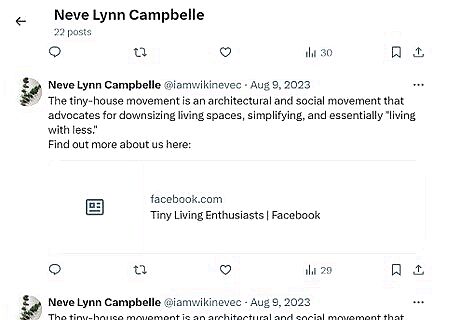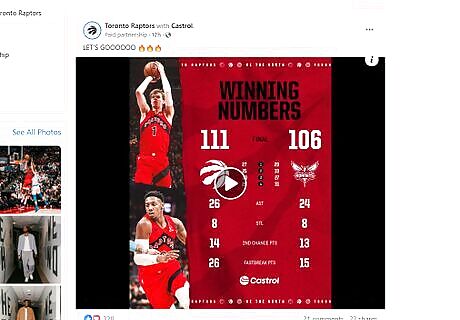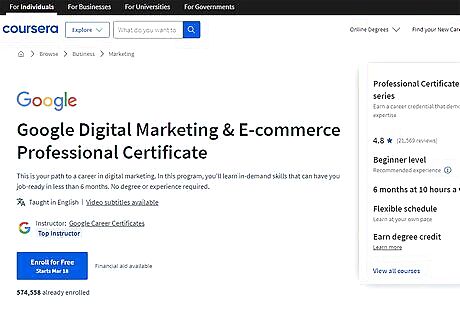
views
- The world of marketing is constantly changing, and if you’re going to succeed you have to be willing to evolve.
- You have to know how to analyze metrics and interpret market trends, and while it’s tempting to put on your creative hat to solve every problem, you have to follow the data.
- Always keep your audience in mind whenever you’re crafting content; just because an idea or campaign resonates with you, it does not mean that it will resonate with your audience.
- There are dozens of ways to make it in the world of marketing and so long as your clients are happy, you’re doing a good job!
Developing Your Personal Skills

Develop your verbal communication skills. Verbal communication is very important when selling products or services or communicating with clients or team members. Practice your communication skills by leading meetings, giving presentations, or practicing in front of a mirror. Being a confident verbal communicator will establish your credibility as a marketer and make you more persuasive.

Practice your writing skills by writing in many different styles. Write in as many different styles as you can to learn how to write in different tones and for different audiences. Try things like writing ad copy, landing pages, blog posts, and professional emails. If you feel that your writing skills are weak, then you can take a writing course to improve them. The more different audiences and channels you can write for, the more effectively you will be able to market products and services to a variety of demographics.

Take courses to learn about different marketing technologies. There are free online courses about things like SEO, coding, and analytics software. Take some of these so you know at least a little bit about some of the different technologies that you will often be working with as a marketer. If you work at a big company, there will often be departments or individuals that take care of the more technical stuff. However, if you know at least a little bit about these kinds of things, it is easier to collaborate across teams or handle small tasks yourself.

Work on developing good time management skills. Create a personal system for staying organized to help you manage your time better. There are lots of time management blogs and other content online that can provide you with tips and tricks to make you more productive. Being able to manage your time effectively is essential to being able to create overall marketing strategies and complex marketing campaigns.

Volunteer to get marketing experience in different areas. Volunteering is a great way to gain invaluable marketing experience, especially if you are just starting out in the field. Find an organization that needs help with their marketing activities and volunteer to tackle the job.Tip: Volunteer work doesn’t have to get in the way of your day job, either. Pick something that will let you learn new skills that you aren’t learning in your regular job and that you can do with a few hours a week of your spare time. For example, maybe your local parks and recreation society needs a community manager to handle their social media. You could volunteer for the task to gain experience in social media marketing. Volunteering doesn’t have to be something formal. For instance, maybe you have a friend who is an entrepreneur launching a product of some kind. You could volunteer to help them out with their paid Internet advertising to help sell the product and gain experience.
Connecting with Your Audience

Look at data on existing customers to understand your customer base. Check out all the data you have on people who have already purchased the product or service you are selling, such as information you have from online sales, or files you have on clients who bought your services. Identify common interests, demographics, and anything else they have in common to get to know your audience. This will help guide all of your marketing strategies to reach more of the ideal audience and sell more of the product or service you are marketing.

Use the customer data to create buyer personas. Look at things like age, profession, hobbies, interests, income, gender, and anything else you identified in the data about your customers to create a persona or personas of your ideal customers. Put together a single-page summary describing all of these traits for each buyer persona. For example, if you are selling hiking boots, your buyer persona might be something like: Male aged 25-50, lives in the Pacific Northwest, works in a high paying job in the tech industry, loves doing outdoorsy things on the weekends, spends his free time reading blogs about hiking and camping gear, and follows adventure and travel lifestyle accounts on Instagram.

Be a storyteller to connect with customers on an emotional level. Good marketers must be good storytellers. All of your marketing campaigns, no matter what channel they are through, need to tell a story to the customer to get them to connect with your product or service.Tip: To become a better storyteller, look at what other successful marketing campaigns have done. Think about what kind of story they are trying to tell and how they are connecting with the audience. For example, if you are selling a backpack, you need to tell a story about that backpack that will make the customers want to buy it. Try to tell a story about the types of adventures owners of that backpack will have. For instance, perhaps they will be able to set off on rugged backcountry hiking adventures, or maybe they will go on an extended trip to Europe and see and experience all the different cultures and history there.
Creating Good Daily Habits

Set goals and prioritize tasks for all your marketing projects each day. Marketers have the difficult job of managing multiple projects and tasks at any given time. This is why it’s important to set the goals you want to achieve each day, and then list out what your tasks are your priorities so that you can achieve those goals. For example, if you need to provide a stakeholder report at the end of the day, then your first priority could be pulling together all the spreadsheets of data you have, then your next priority could be compiling relevant data into charts and graphs, and the last priority could be putting those charts and graphs into a slide presentation with some bullet points explaining the data. Find a way to help you manage your time and priorities that works best for you. For some people, this can be as simple as manually writing out a list in a notebook, or for others, it can be helpful to use something like project management software to stay organized.

Monitor the web to see what the competition is doing. Identify your main competitors and monitor what they publish or do marketing-wise each day. Take note of whether they are doing anything new or whether there are any opportunities you can take to promote your business. You can use tools like Google Alerts, Hootsuite, X Pro (formerly TweetDeck), and SocialMention to monitor your competition online and on social media so that you don’t miss any important updates or posts.

Read the news to stay current on your industry and new marketing trends. Industries and marketing are changing rapidly, so you need to make sure you don’t fall behind. Read any publications relevant to the industry you work in, as well as publications about the marketing industry, and apply any learnings to your marketing campaigns. You can use the same tools you use to monitor the competition online to set up alerts for certain keywords or hashtags so that you get the latest news online. For example, if there is a new social media channel that is gaining traction among the photography community, and you are selling cameras, then you want to start developing a marketing strategy for that network as soon as possible.

Look for insights in data and make data-driven decisions every day. Look at the data across all of your marketing channels and analyze it to see where customer leads and sales are coming from. Use the data to optimize your campaigns or to change your overall strategies. For instance, if you see that 1 of your advertising channels is driving 80% of customer engagement, you might decide to allocate more budget there, and get rid of the other channel and replace it with another one to try something new. If you aren’t a numbers person, then find someone who is and work with them to analyze data. People who have backgrounds in statistics, are good with Excel, and know how to use different analytics tools are invaluable on your marketing team.

Be creative and experiment with different strategies and tactics. Experiment with 1 new marketing strategy or tactic every day. Brainstorm with your team or alone to come up with new ideas to drive growth with your marketing campaigns.Tip: You can also get creative and experiment with how you and your team do things internally. For example, try out a new collaboration tool or project management software and see if it helps improve your productivity and results. Every marketing strategy is unique to a certain product or service, situation, and audience. Try to tailor your marketing campaigns to your unique set of circumstances. For example, you can try adding new keywords to your pay-per-click advertising campaigns on Google and see if it increases or decreases the number of clicks you get. If you are only posting on your blog once a week, you could try posting twice a week or on a different day and see if it changes the amount of traffic you are getting.

Evaluate how you did at the end of each day and how you can improve. Measure whether you were able to increase leads, sales, or get new clients. Think about whether you were able to prioritize efficiently and what your accomplishments for that day were. Tweak your routines and priorities the next day to be even more productive if you see areas for improvement. For example, maybe you didn’t get all the reporting you needed to done one day. In that case, you can change around your list of priorities so that reporting is something you take care of first thing in the morning, then you can move on to strategic planning in the afternoon.
Using Effective Digital Marketing Tactics

Develop a content marketing strategy for the most relevant channels. Look at how much traffic you are getting from each online content channel you have (like your blog, social media networks, and paid ads), then create a content schedule for publishing each type of content to each channel that focuses on the highest-traffic ones. Content can come in the form of articles, social media posts, ads, and other digital marketing channels. Really, everything you do in marketing is content-based. For instance, if you have a blog that is driving a large amount of traffic to your company’s site, then focus on creating quality content there every day. If you are receiving a lot of traffic via Instagram, then you want to make sure to keep publishing quality, engaging content there. Just because you see that you need to focus on 1 area doesn’t mean you should completely ignore others. A well-rounded content strategy is key to a good digital marketing campaign.

Use visual marketing in your content and advertising to drive user engagement. Things like videos, GIFs, and infographics posted on your social media channels or blog are great for creating user engagement. People love to share these things, which will give your brand more exposure. Work with a good photographer or graphic designer to develop great visual content for your digital marketing strategies. Content with relevant images receives 94% more views than content without.

Be very specific with your paid social media targeting. Paid advertising via big channels such as Instagram and Facebook allows you to target a very specific audience that is more likely to buy your product or service. Use your buyer personas to help you target your ideal customers based on demographics.Tip: You can find lots of online blogs, websites, and video courses on paid social media advertising to help you learn how to be more specific with your targeting and reach a higher-value audience. You can target potential customers based on general things like age, location, and gender. Then, you can narrow it down even further based on things like what types of accounts they follow, what pages the like, or what posts they interact with. For example, if you are selling basketballs in Canada, you can target people between the ages of 16-35 who live in Canada and have liked posts from the Toronto Raptors’ Facebook page or Instagram account.

Segment your email marketing lists to target certain niches of customers. The most loyal and engaged customers often communicate by email. Segmenting email lists means separating them into different groups of people who meet different criteria to send different types of emails. This allows you to craft your emails to be more relevant to different groups of people. For example, if you have a project management software company, you can send a certain email advertising an extra feature to users who have been active on their accounts in the past week who would be more likely to buy the extra feature. You could send a different email out to users who have signed up but have not started using the software to remind them to get started. You can use split testing to test out different emails on a segment. Split testing refers to sending at least 2 different versions of an email to 2 different groups of a segment, and then seeing which one receives a higher open rate and more interactions to determine which email is best to send out to a larger audience of that segment.

Keep learning about digital marketing to stay up-to-date with the field. Go to conferences, attend webinars, take courses, and network with other digital marketing professionals to keep developing your skills. Digital marketing is changing faster than any other area of marketing, so it is especially important to stay current. Digital-specific things to stay aware of in marketing are algorithm changes in big search engines like Google, changes to social advertising, and the rise of new analytic technologies or digital marketing channels. You can always learn new digital skills. For instance, if you are more of an analytics person, you can focus on learning how to write digital ad copy and blog content. The more different things you can do, the better you will be as an overall marketer.


















Comments
0 comment